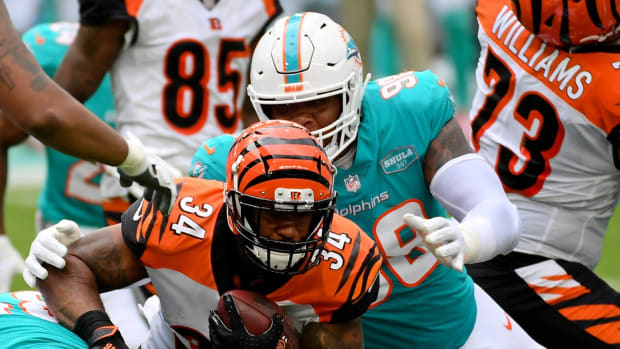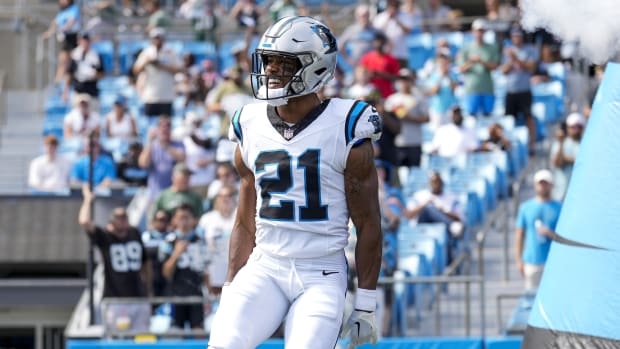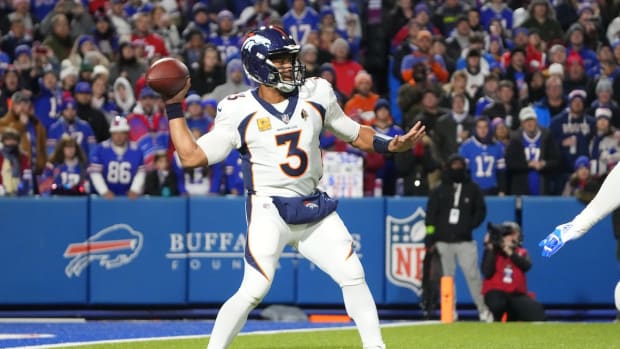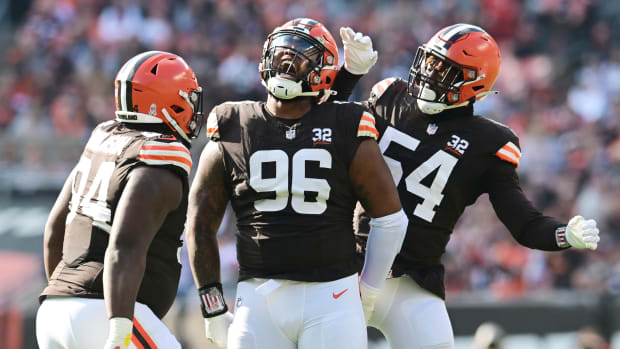Inside the Minds of the NFL’s Six New Coaches
The best thing about the NFL draft is that it forces honesty. In the decisions they make, coaches and GMs tell us what they really think about their players and how they really feel the game should be approached. This year, six teams will make decisions with new head coaches. Aside from Doug Marrone in Jacksonville, they’re all first-time head coaches. Here’s an overview of each man’s core beliefs and how it will impact his team’s draft.
Sean McVay
Los Angeles Rams
As an offensive designer, McVay relies heavily on geometry, especially through the air. Many of his pass designs involve multiple routes working together to exploit a predicted defensive coverage. He tries to regulate those coverages with his receiver spacing and distribution. He’ll figure out what a defensive coordinator calls versus specific formations in certain down and distances, and he’ll align his receivers in places that compromise those calls. This can be very nuanced. For example, there’s a big difference between a receiver lining up, say, 12 yards from the sideline versus 10 yards from the sideline. Where receivers align in relation to each other is also huge, as is presnap motion. With this sort of approach, you need a variety of different styles of receivers. As the offensive coordinator in Washington, McVay had a true speedster in DeSean Jackson, an inside possession receiver in Pierre Garçon, a shifty slot weapon in Jamison Crowder and a mismatch-making tight end in Jordan Reed. The skill sets of all four players complemented each other. The Rams’ receiving corps is decidedly less diverse. (And less talented.) Ex-Bill Robert Woods is essentially Garçon minus some strength and Crowder minus some quickness. Tavon Austin looks like a slot receiver but isn’t patient enough to play there. The rest of the receiving corps is comprised of backups. To run McVay’s scheme, the Rams need several new wideouts.
• ANDY BENOIT: How Sean McVay Became the NFL’s Best Coaching Candidate
Kyle Shanahan
San Francisco 49ers
Shanahan’s Falcons offense was the best in football last year. Privately, some coaches even said it was the best they’d ever seen. Its brilliance was in the way it used running backs, fullbacks and tight ends. Shanahan would align those players anywhere on the field, giving the Falcons an unlimited supply of formations. Often, those unconventional formations would compel the defense to reveal whether it was in man or zone coverage. Knowing this would be the case, Shanahan would design for routes on one side of the formation to beat man coverage and routes on the other side to beat zone. Matt Ryan would examine the defense, identify man or zone, and choose which side to work accordingly.
Amazingly, Shanahan thrived with this despite only having two players amongst his running backs, fullbacks and tight ends who could pose problems in both the running game and passing game: Devonta Freeman and Tevin Coleman. In San Francisco, he may not have any. Carlos Hyde is a classic running back. Kyle Juszczyk is an adept passing game fullback, but not to the extent that he can split out wide or in the slot. Tight end Vance McDonald could maybe play the slot, but he won’t scare opponents if aligned on an island. Imagine how potent Shanahan would be if he had some mismatch-makers at these positions. Expect the Niners to look for versatility at running back or tight end.
• PETER KING: Kyle Shanahan on Why He's Ready to be a Head Coach
Sean McDermott
Buffalo Bills
By deciding to let cornerback Stephon Gilmore walk in free agency, the longtime defensive assistant under the late Jim Johnson in Philadelphia and the highly respected Ron Rivera in Carolina has already told you how he views the game. Gilmore is a lanky, athletic man-to-man defender. Most defenses would kill for a corner like him. The Bills were one of those defenses under Rex Ryan, who preferred one-on-one coverage outside and overloaded pressure designs up front. But McDermott plays a lot more zone. On early downs, it’s eight in the box with a safety patrolling centerfield. On passing downs, it’s seven in the box, maybe with an inside blitz look, and two safeties back deep. This approach naturally protects corners; almost always, they have help from a safety over the top or from a linebacker underneath. And so instead of spending money on a pricey cornerback you can spend it on linebackers and pass rushers. McDermott’s old team, the Panthers, did exactly that by letting Josh Norman leave in free agency, signing Thomas Davis and Luke Kuechly to long-term contracts, and consistently selecting defensive linemen early in the draft. The Bills will follow this model. Almost any position in their front seven can be upgraded.
Anthony Lynn
Los Angeles Chargers
The 48-year-old Lynn has coached NFL running backs since 2003; he also played the position for more than a half-dozen years in the ’90s. The assumption is he’ll want to pound the rock. And maybe he will. But Lynn’s football mind spans wider than the running game (he would not have become an intriguing head-coaching candidate if it didn’t). He realizes that when you have Philip Rivers under center and Ken Whisenhunt calling plays, it’s in your best interest to throw. Besides, even if you call a bunch of runs, a veteran field general like Rivers will audible into passes if the defensive look allows.
This doesn’t mean the Chargers will draft a receiver. With Keenan Allen back healthy, they’re much deeper here than people realize. Travis Benjamin gives them speed, Dontrelle Inman is a tremendous route runner and Tyrell Williams, though raw, can be a big downfield weapon. Plus, tight ends Antonio Gates and Hunter Henry give the pass designs texture and dimension. But the Chargers have learned the hard way that your pass designs are only as effective as your pass protection. The interior of this offensive line needs shored up. Whoever starts at guard/center must be big and mobile, which likely means he’ll have to be an early round pick. Because when Lynn does keep it on the ground, he’ll feature pull-blocking concepts and road-grading double-teams. That’s what he ran in Buffalo and that’s what best fits third-year tailback Melvin Gordon.
• JENNY VRENTAS: Anthony Lynn and LeSean McCoy’s New Reality
Vance Joseph
Denver Broncos
Meet the NFL’s most mysterious new head coach. Joseph only spent one year as a defensive coordinator (2016 in Miami). Before that, he had been a secondary coach for the Niners, Texans and Bengals. In Miami, Joseph ran many of the straight zone concepts that he learned in Cincinnati. His approach was more about putting players in position to execute with speed, rather than trying to out-scheme opponents. But here’s the tricky part: Joseph is inheriting an ultra-talented Broncos D that spent the last two years beating teams through pressure designs. Most pressure concepts require man coverage on the back end. (The pressure forces the QB to throw quickly, so you want your corners up on the receivers early in the routes.) With three elite cover corners—Aqib Talib, Chris Harris and Bradley Roby—there was no pressure tactic the Broncos couldn’t employ. This approach earned them a Lombardi Trophy in 2015. Will Joseph have those corners now sit back in straight 4-3 zone looks? Let’s hope not. He’d be wise to follow in the footsteps of his predecessor, Wade Phillips, and keep changing his front looks while playing man coverage behind it. Whether he’ll actually do that remains to be seen. And we might not have any hints until training camp, because the Broncos are likely to spend their early round draft picks on offense.
• PETER KING: Vance Joseph on His New Denver Gig
Doug Marrone
Jacksonville Jaguars
As the head coach in Buffalo for two seasons, Marrone’s Bills often employed defined reads for the quarterback. But that may have been by necessity given that his QBs were EJ Manuel, Thaddeus Lewis and Kyle Orton. Marrone inherits another struggling quarterback in Blake Bortles, but Bortles has shown a much higher ceiling than Manuel or Lewis ever did. In theory, you can run a full-fledged NFL offense with Bortles. The question is: What style of offense? Marrone is an offensive line expert. He’s also working with Tom Coughlin and has a very talented defense. They’ll likely want to control games on the ground. Getting a power back will help, but another dimension would be to use multi-tight end packages. (They help keep defenses in simpler looks.) After trading Julius Thomas, the Jaguars signed ex-Raider Mychal Rivera. (He’s not the receiver that Thomas is, but he’s not as big a blocking liability, either.) Their other tight end is 11-year veteran Marcedes Lewis. It wouldn’t hurt to become more athletic and versatile at this position.
• Question? Comment? Story idea? Let us know at talkback@themmqb.com










































